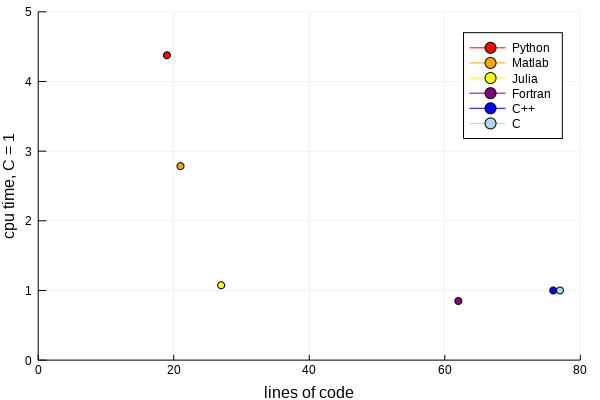A new programming language specifically made for scientists and engineers.
Walks like Python, runs like C.
Note: ~5 years ago at MIT
Note: to build complex compiled programs OR to have fast dynamic programs, you have 2 languages involved
- Brain-storm in a dynamic language for algorithm exploration and testing.
- Deliver a performant final-version in a compiled language.
Note: Most compiled programs had a testing stage in a dynamic language
Does a package/library do exactly
what you need?
├── Yes: Great!
├── Dunno: You need to read C/++ code.
└── No: You need to code in C/++.
Note: R, Python, and MATLAB are coded mostly in C/++. Anything that is fast in those languages is coded in C/++.
- Benchmarks
- Solves the two-language problem
Juliais mostly coded inJulia!
Note: Julia is mostly coded in Julia!
Note: The algorithm here is the KS-CNAB2 algorithm for numerical integration. Taken from https://github.com/johnfgibson/whyjulia/blob/master/1-whyjulia.ipynb
- Just-in-time compilation (JIT): User-level code is compiled to machine code on-the-fly.
- Meticulous type system: Designed to maximize impact of JIT.
- Multiple dispatch: Function dispatch determined at compile time when possible, run time when not.
Note: JIT compilation times are slow for first run
Looks like Python/MATLAB/R but with prettier syntax.
Note: Unicode characters, degree symbol, Greek letters, square root, units. Easy to read and understand, scientists are not programmers.
# rotate coordinate `c` by `θ` radians
julia> ↺(c, θ) = [cos(θ) -sin(θ); sin(θ) cos(θ)]*c
↺ (generic function with 1 method)
julia> [1,0] ↺ π/2
2-element Array{Float64,1}:
0.0
1.0Note: This opens the door to tons of cool syntax.
It took a beetle 36 seconds to walk 25 cm. How many days will it take it to walk 3 km?
using Unitful:uconvert, cm, km, s, d
v = 25cm/36s
t = 3km/v
uconvert(d, t)5 days
Note: if you use m, cm, feet, degrees, radians, etc
The concept of missing and NaN is treated correctly:
julia> NaN + 1 = NaN
julia> missing + 1 = missing
julia> true | NaN ERROR!
julia> true | missing = true
julia> false | missing = missing
julia> true & missing = missing
julia> false & missing = falseNote: Consider that no other language has managed to get this concept of missing data correctly into their code.
Full access to all the libraries and functionalities you already know.
MATLAB.jl, RCall.jl, PyCall.jl, JavaCall.jl, Mathematica.jl, and ccall keyword to call C (and other languages, like Fortran and Rust)
Note: you can call Julia home without losing all of your furniture in the move.
It is a modern language that makes your life easier.
- QuantEcon: Provide lectures on models including code!
- QuantEcon.jl, a package with most of the functionality that you need, e.g. CompEcon.jl.
- Parameters.jl: Use parameters more comfortably.
- Queryverse.jl: Like R's tidyverse? There is something similar in Julia!
Note: There are many more things as well. DataFrames are nice, Gladfly (Grammer of Graphics), Piping operator |>, etc.
- Macros aka meta programming:
- Want to know how fast your function is? Use
@btime foo(), it runs your function many times averaging durations. Also information about allocation of memory. - How to make your code faster?
@trace - Want to see the machine code?
@code_native
- Want to know how fast your function is? Use
Note: It is easier to write good code in Julia, there is more guidance.
githubintegration: your code and its documentation accessible to everyone.- You can view the code of packages you are using and read it (most likely written in Julia)!
- Makes it easy to contribute yourself. File issues with developers directly, bugs are quickly fixed.
- Discuss your problems with the growing Julia community on discourse.
Note: Sometimes even core developers chime in! Friendly experiences so far.
Juliaenjoys growing popularity - also in economics.- The NY FED ported their DSGE model from
MATLABtoJuliaand it became a lot faster (up to 10x).- They also wrote a package: DSGE.jl
- Mainly a substitute for Dynare is missing - Dolo.jl is offering some of its functionality.
- Here you can find a speed comparison of different programming languages in economics.
Note: More and more people are using Julia for their econ papers. If you have not invested heavily into MATLAB yet, you should give Julia a chance.
- Easy to share and collaborate with anyone
- Drives the language forward
- Highly specialized and niche solutions and tools
- Free from hardware requirements
- No "black boxes", everything is within reach
Note: This is true for Python and R, but not MATLAB. Julia got git integration really well.
Mostly it's just too new…
Note: nothing is perfect.
- Ecosystems (e.g. packages, IDEs, debugger) not as mature as in other environments.
- Some of the more specialized libraries are missing.
- Harder to Google for answers.
Note: IDE (Integrated Development Environment). Maybe in 6 months or so the environment will solidify completely. Atom is, however, a really cool tool.
- Loading some packages is still a bit slow.
- Plotting works but hasn't settled yet.
- Data analysis not yet as convienent as in
R. - Transitioning into
v1.0.0: Major changes.
Note: Things missing are debuggers, viewers for dataframes, breaking points etc. I also managed so far without.
- Need statistics?
R - Need vectorized operations on matrices?
MATLAB Julia(likePython) is more general-purpose → can be harder to find what you're looking for.- But if you can do it all in Julia - that's nice.
Note: apropos statistics, Douglas Bates, the developer of the lme4 (Linear Mixed-Effects Models) R package for GLMMs switched to Julia.
Juliais considered by many one of the best dynamic languages out there.- A number of libraries already far out-perform their equivalents in other languages.
- People come to
Juliabecause of its speed, but stay for the type-dispatch system ♥ - Suffers from being "too new": might not be suitable for early adopters.
Note: I've started using Julia about two years ago and never looked back.


